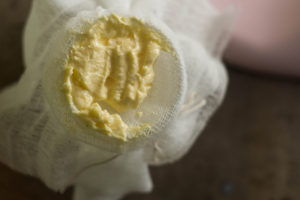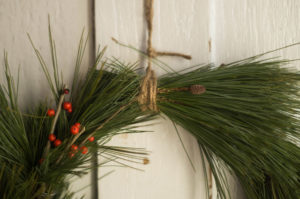This past summer, we moved into my grandma’s house after she passed away. I had grown up exploring the nooks and crannies of her old brick house, eating after-school snacks and a homemade supper with her and my grandpa nearly every day. When my husband and I first walked into the house, I knew there would be treasure to unearth.
Sure, the rooms had been cleared out and it felt like a blank canvas for our own lives to be painted upon, yet I knew in a deep and tangible way that we would stumble upon things she had intended precisely to be found.
One fateful afternoon while oiling our bevy of Lodge cast iron skillets, my husband opened the drawer beneath the oven to reveal a 8-inch Griswold cast iron pan in immaculate condition. Black, shiny, impossibly smooth. It was sporting the nourished patina that only a decades-old, cared-for cast iron pan can sport. I have no doubt she cooked thousands of meals in this pan — in fact, I remember her using it. The weight of the pan became too much for her to use later in her life, thus it was relegated to the bottom and back of the drawer, altogether forgotten about.
We have made a concerted effort in our marriage to maintain our cast iron cookware in hopes that it will someday be passed down to our children, and their children, and so on. We are working to create heirlooms. Depending on the heirloom in question, the value might be nominal—valued at pennies, even—but the worth is another matter entirely. To us, grandma’s pan is worth more than gold. I won’t deny that we are partial to cast iron as a cooking vessel and some might even call us a little sentimental, but might there be a reason cast iron has stood the test of time for centuries, while new and “improved” cookware enter and exit kitchens every year? Might a cast iron pan be just the sort of heirloom to invest in now, enjoy until you can no longer handle the weight of it, and then pass it down? Or, like my grandma, set it somewhere to be found on a fateful afternoon by an unsuspecting someone. Family heirlooms are quiet invitations to wonder—to marvel—at the storied history suffused in the object. Who made it? Who cared for it? Who cooked in it? How much did they love it? On the subject of love, and in the case of grandma’s Griswold pan: very, very much.
Editor’s Note: This article was first posted in January 2018.
































My mother died recently, and we, too, have found her cast iron pans: Oiled and in the oven, black and smooth as all get-out. I remember the periodic ash burning in the deep brick fireplace at grandma’s, the uncles tending it and other skillets. I remember all the meals, too. I learned to cook over easy eggs, fried chicken, squash and onions, fish, and later baked goods. I always took for granted the convenience of the seasoned surface and seldom having to worry about it slipping on the eye of the stove. That heftiness only needed gloves nudges after practice. One day my grands may ask, “What did you cook in those?” My pans will still be around, too.
I spent most of my youth, with my grandparents. I listened and learned more than I could ever recall. My first cast iron skillet was given to me after my great aunt passed. It started a journey that I continue to this day, 40 years later.
I scour yard sales, thrift stores and flea markets for old cast-iron cookware and restore the pieces to a usable heirloom. Not always an easy job but it is a labor of love for me. I then give these beautiful usable gifts for special occasions. Mostly they go to family but some have gone to friends as well. Nothing compares to vintage well seasoned pots, dutch ovens and skillets. Nothing compares to the story each one holds forever in silence.